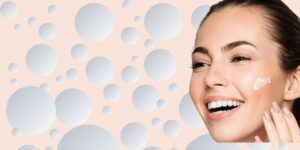Introduction
Hydroxy acids, then called alpha-hydroxy-acids (AHAs), were discovered in the 1970s by Drs Eugene J. Van Scott and Ruey J. Yu. They were found to be vital antiaging ingredients with exceptional benefits to maintain a youthful appearance. They are naturally occurring organic acids found in fruits and food and function as skin exfoliators to peel off dead layers of cells in the stratum corneum to stimulate skin renewal. They also stimulate collagen production to restore healthy tissue for a more youthful skin appearance.
The first generation hydroxy acids (AHAs) such as glycolic and lactic acid were often skin irritating for people with more sensitive skin. Second generation Beta-hydroxy-acids (BHAs) such as salicylic acid are less irritating. The new generation poly-hydroxy-acids (PHAs) such as Lactobionic Acid are reported to be as effective as AHAs but much less skin irritating1.
Benefits for Your Skin
“Antiaging effects of cosmetic alpha-hydroxy acids (AHAs) have been demonstrated in rigorous clinical studies that have been published in peer-reviewed journals.”2
The skin benefits offered by hydroxy acid treatment are well established and well supported by research. Hydroxy acids offer the following skincare benefits:
1. Dry Skin Treatment
Treatment of dry skin conditions with AHAs restores the startum corneum and the epidermis to a more normal clinical and healthy state3. Combinations of BHA and PHA show even greater efficacy for treating dry skin types3.
2. Sensitive Skin and Rosacea
PHAs and BHAs are more compatible with sensitive skin types than AHAs as they are more gentle of the skin.
3. Hyperpigmentation Treatment
With sustained treatment by AHA’s, lightening and even complete fading of hyperpigmentation can be achieved.
4. Anti-aging, Photoaging Treatment
Antiaging benefits of reduced wrinkles and fine lines can be achieved with the daily application of AHA’s to the skin3. This can result in increase in dermal thickness and firmness that persists after application ceases. AHAs increase skin production of collagen and hyaluronic acid which result in thicker and firmer skin.
5. Peeling Agents
AHAs are used in chemical peeling procedures and at lower concentrations are used as at-home gentle peels to increase skin exfoliation and cell turnover. As we age our skin cells turnover slows down and this contributes to the aging process. Daily application of AHAs accelerate epidermal and dermal renewal for more youthful looking skin.
6. Enhance Skin Barrier Function
The Stratum Corneum is the thin outer layer of cells that protect the skin from attack by environmental factors. AHAs can enhance the skin barrier function by increasing ceramides within the stratum corneum1.
7. Acne and Acne Scar Treatment
The skin peeling and desquamation effects of AHAs, BHAs and PHAs make them suitable for the treatment of acne4. BHA, salicylic acid is one of the best peeling agents for treatment of acne and acne scars.
8. Antioxidant Action
Polyhydroxy acids (PHAs) such as lactobionic acid are also antioxidants and can be combined other active ingredients for added benefits1.
Discussion
“The “physiological” desquamation provided by salicylic acid provides smoother texture and appearance to the skin and can give the illusion of decreased pore sizes.”4
Use of new generation, nano-formulation technology means we can combine hydroxy acid types for added skin benefits. We can combine, in a single serum, AHA, BHA and PHA to provide a potent but gentle antiaging serum. Nano-encapsulation of active ingredients provides both enhanced ingredient stability and superior skin penetration of hydroxy acids.
References
- 1.Edison B, Green B, Wildnauer R, Sigler M. A polyhydroxy acid skin care regimen provides antiaging effects comparable to an alpha-hydroxyacid regimen. Cutis. 2004;73(2 Suppl):14-17. https://www.ncbi.nlm.nih.gov/pubmed/15002657
- 2.Green BA, Sabherwal Y. Antiaging Benefit Ingredients: AHAs, BHAs, and Bionic Acids. In: Procedures in Cosmetic Dermatology. 3rd ed. Elsevier; 2016:99-116.
- 3.Green B, Yu R, Van S. Clinical and cosmeceutical uses of hydroxyacids. Clin Dermatol. 2009;27(5):495-501. doi:10.1016/j.clindermatol.2009.06.023
- 4.Decker A, Graber E. Over-the-counter Acne Treatments: A Review. J Clin Aesthet Dermatol. 2012;5(5):32-40. https://www.ncbi.nlm.nih.gov/pubmed/22808307












